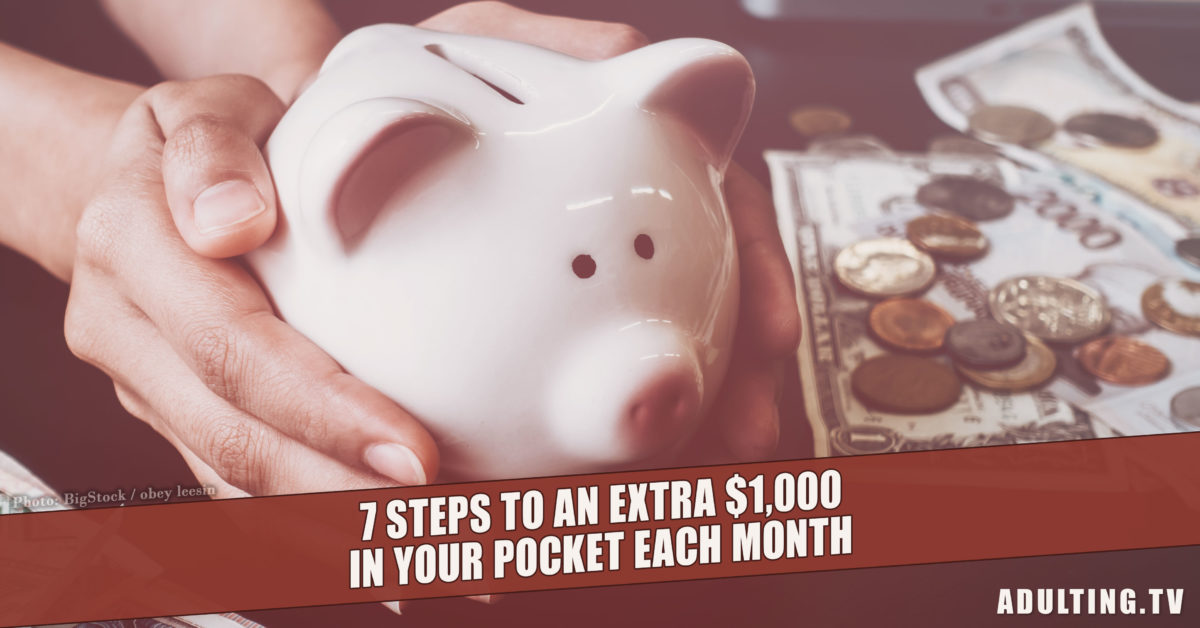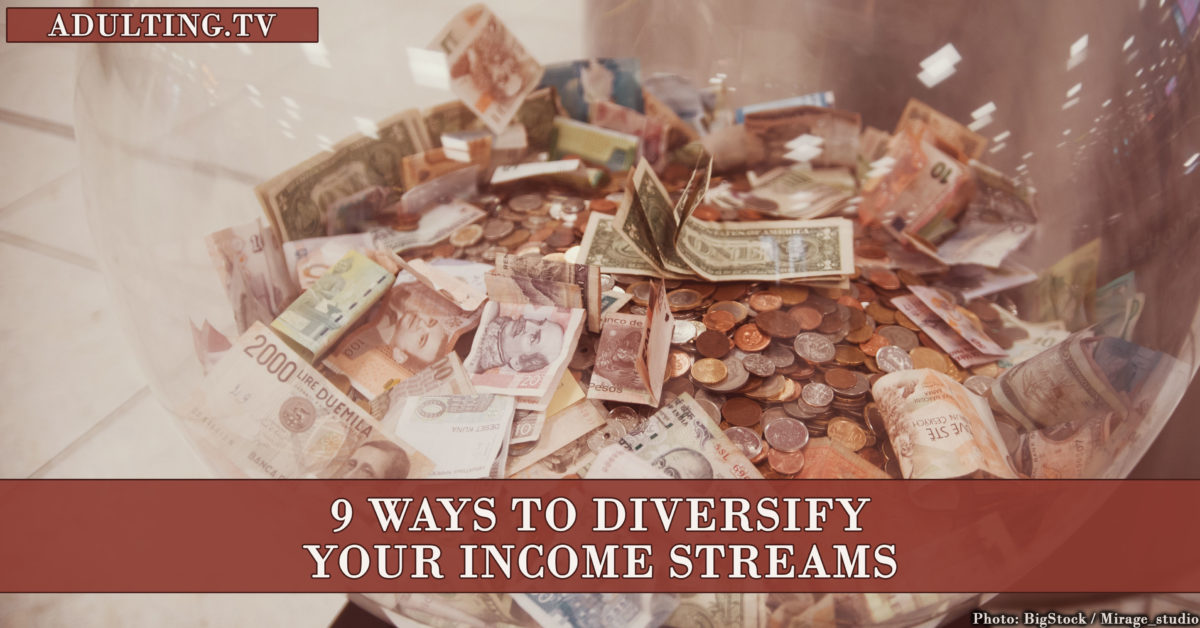It’s often said (most notably by Dave Ramsey) that you need at least $1,000 saved for emergencies.
In my experience, this is often been the case.
Like when my car finally gave up the ghost and some random belt in it broke. Cost for the repair: $1,300. And, yes, I plan on paying it.
But I don’t have to like it.
What about when my neighbors and I had to replace our roof? Deductible: $1,000.
I’m not the only one, either. A relative of mine needed to get some major dental work done and they had to pay $1,000 towards their deductible.
You need at least an extra $1,000 cash at all times. And, fortunately, it’s not too hard to do once you decide it’s time to get that emergency fund built. (Although there are some circumstances in which it might be impossible for you to reach this goal right now.)
For simplicity’s sake, though, we’re going to assume that most things are going well in your life and that you just would like to make an extra grand for whatever reason.
An extra $1,000 in a month: set the goal.
It’s amazing how often people underestimate the value of setting goals. Each goal has an energy and a process of its own.
You decide on the goal, then you break it down into workable parts. The idea is to make it manageable over time. It’s not something that you just accomplish immediately. However, having that goal — something to work for — can help you stay motivated and give you focus.
Some people start with the end result in mind and then work backward. This is a great approach that works for many people. By figuring out what the result should be, they can then put together a plan with steps to help them reach those goals.
Personally, I find that a bit confusing. I prefer to work from the beginning towards my end result. When focusing on financial goals like getting an extra $1,000 in your pocket each month there are a couple of things to consider.
First, ask yourself: Could you achieve this goal by changing your job?
Finding a new job may take longer, but once you find a job that meets your “earn more” criteria you’re all set. Nothing more needs to be done.
What if you love your job and just would like to side-hustle your way to an extra grand each month? Or what if it’s just not practical to get a new job? Maybe you just want the extra money so you can work on financial independence.
If these situations apply, you need to take different steps to achieve your goal.
Decide on your “how.”
You’ve created your goal and now you need to decide how you’re going to make your extra $1,000 per month.
If you’re side hustling, you may end up going down a rabbit hole of choices.
There are a ridiculous number of ways to make money. The most important consideration to keep in mind is the following: you should avoid paying money to make extra money whenever possible.
Next, do your best to enjoy whatever hustle you add to your week.
One of my favorite side hustles is brand ambassador work. I have a friend who runs a team of brand ambassadors for a local brand here in Colorado. The best part about working on her team is that once we’ve run out of whatever product we are tasked with sampling, we’re still paid for the entire shift.
There are times I’m scheduled for a four-hour shift and the work is done in one hour. And I get paid for the remaining three hours. Nice.
But that’s not the only side hustle you can use to get an extra $1,000 a month. Think about what you enjoy. Whether it’s selling stuff on Etsy, driving for Lyft, or pet sitting, think about what you might enjoy that others are willing to pay for. From writing to taking pictures, there are plenty of amazing side gigs that can help you grow your wealth.
For some inspiration to get you started, here are our suggestions on how to Make $200 a Day with These 57 Side Hustle Ideas.
Daily focus.
What are the tasks that you need to focus on each day to attract more money to you?
The way you approach your gigs and your life can make a huge difference in getting that extra $1,000.
For example, if you’re interested in brand ambassador work and live in a mid- to large-sized city, the best time to start signing up for these gigs is during the months May through October. Each product activation varies by length of time, but typically these gigs last most of the summer months.
On top of that, if you are interested in attending events for free and getting paid, the summer months are ideal for making a little extra money. Event season starts to ramp up — and events need people to work them.
Wedding season is also in full swing during the summer and a well run wedding needs help. You can also pick up clients if you’re a freelance photographer or videographer. It’s a fun side gig and you see people and families at the happiest.
It’s not just about working toward side gigs during the summer, though. Tap into your network.
Maybe you need to tell people every few days that you’re looking to make some extra cash. Share on social media that you’re available to help people by using your talents.
In fact, I just had a friend reach out to me this week who needs help running an event at the school her kids attend. I would have helped for free (she’s a friend) but she also mentioned that they were paying and feeding people. Done.
Time vs. income.
Not all side hustles are created equal, though.
The most sought-after side hustles make a lot of money in as short an amount of time as possible.
There is a reason why people love freelance writing. If you’re a reasonably fast writer and editor you could potentially write for a couple of clients a month and easily make that extra $1,000.
A lot of bloggers focus on creating passive income with this metric in mind. It takes a lot of work in the beginning, but, once you begin making a steady passive income stream, pretty soon that income has its own little money babies.
But you have to be careful. Are you using your time productively? For example, rideshare driving can be a solid way to earn money. But is it worth it to spend five hours driving around (not to mention paying for the cost of gas) only to end up with three fares, making $35. That’s less than $6 an hour.
Carefully pay attention to your return on investment with your time. You don’t want to spend a ton of time on something that doesn’t end up providing you with a good return. Try a few things. But if it turns out to be a dud, you might have to abandon the idea and move on to something else.
Don’t be afraid to try new things to make extra money. But also don’t be afraid to pivot when needed.
Trim the Fat.
You may already have an extra $1,000 in your budget and not even know it.
What if you just need to focus on your spending and monthly expenses?
I cut $13,500 from my annual budget by focusing on my monthly expenditures. I changed my phone service, cut down on clothes shopping, tracked my daily spending, and stopped shopping for groceries like a fool. By taking these steps I averaged a savings of $1125 a month.
While some folks really are already down to the bone, the fact is that many of us might be surprised to really look at our finances and see there’s room to cut back. Be honest as you go through your costs and be ruthless as you cut back on things that aren’t helping you reach your goals.
Replace some of your pricey activities with free or low-cost fun. Look for discounts and free samples on your favorite products. If you can spend a few minutes each week to save some money on your spending, you can enjoy life that much more — and get to your goal much faster.
Start today.
It may feel a little overwhelming to save an extra $1,000 if you’re not in the habit of aggressively saving money.
And, let’s face it, most Americans struggle with building up their savings.
Don’t get stressed out, though. Just start. Maybe you make $200 or $500 extra this month, instead of $1,000. That’s ok. It’s $200 or $500 more than you had the month before.
Start today. Do one thing to help grow your wealth today. Get started. You’ll be surprised at what you can accomplish.



![[B037] Boost Your Confidence to Be Your Own Boss ft. Monica Louie](https://adulting.tv/wp-content/uploads/2017/09/monica-louie-1200x628.jpg)






![[B022] Be an Entrepreneur While in School ft. Eva Baker, The Teenpreneur](https://adulting.tv/wp-content/uploads/2017/03/entrepreneur-in-school-1200x628.jpg)